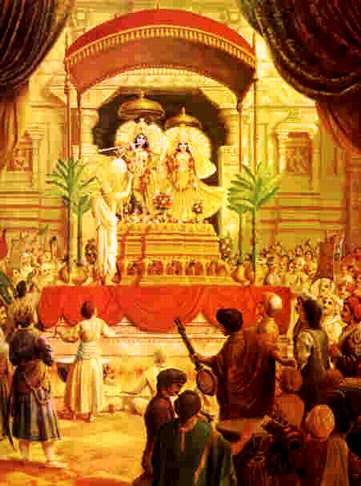
last updated 1st November 2003

Question. I have full faith that Krsna is always in control, but how does one come to terms with the fact that during the history of the Islamic conquest of India, Muslim invaders were able to plunder Hindu temples and make a sacrilegious display of destroying the Deities that had been worshiped on the altar? If Krsna were in control why would he want this to happen?
Answer from HH Swami B. V. Tripurari (Tripurari Swami):
The presence of God within the Deity is to a large extent dependent
on the devotion of the servants of the Deity. It is the power of their
love that causes God to descend in Deity form and accept worship. Thus
the acarya who is representing the Lord presides over the ritual in which
the Deity is established. The acarya actually has love of God, and on the
strength of this love (constituted of God's svarupa sakti), God agrees
to be present in Deity form to accept worship from the acarya's disciples.
Sometimes over generations a particular acarya's lineage becomes devotionally weak, and to this extent the Deity appears to withdraw. In such instances we find that the Deity's worship is neglected, the temple may be abandoned, or the temple worship turned into a business. However, sometimes even when the devotion of the Deity's servants is strong we find that the Deity's service is interrupted, or worse still, offenders destroy the Deity. In such instances God teaches us that while he is symbolically represented in his Deity form and fully present therein, his existence is not limited to this symbolic representation.
Deity worship (arcanam) is particularly important for neophyte devotees, arcayam eva haraye pujam yah sraddhayehate . . . sa bhaktah prakrtah smrtah. Arcanam involves entrance into the ritualistic world, which is an approximation of the spiritual reality and includes material elements within it. It is the realm in which God makes himself available in a form that devotees still living in material consciousness can approach, thus bridging the gap between them and himself. Such devotees have a conception of divinity that is tainted by material notions (prakrtah bhakta). Thus in rare instances, to help neophytes transcend their limited material notions about divinity, the Deity allows itself to be destroyed. At that time the devotion of neophytes, as well as their understanding of the philosophical underpinning of their practice, is tested in order that they might advance in their understanding and devotion. At that time the Deity, while appearing to be destroyed, withdraws into the hearts of his pure devotees, and when such devotees see fit, they again establish the Deity's service. God's ways are mysterious, as are those of his devotees in whose hearts he dwells. God is more substantially present in the hearts of his pure devotees than he is in his manifest Deity form (arca vigraha).
Questions or comments may be submitted at the Q&A Forum
http://www.swami.org/sanga/ or email sangaeditor@swami.org.
+++++++++++++++++++++++++
Moderator: sangaeditor@swami.org
Date: Thursday, October 16, 2003 Vol. V, No. 24
Readership: 11,797
Back issue archive: http://www.eScribe.com/religion/sanga
Sanga website: http://www.swami.org/sanga
Audarya Bookstore: http://www.swami.org/merchant.mv
~~~~~~~~~~~~~~~~~~~~~~
If you need to update your contact address, please drop us a note at
editor@swami.org. Thank you.




